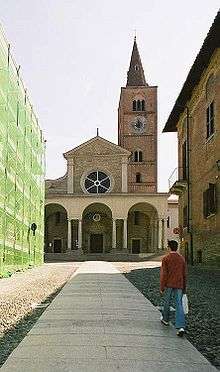Acqui Terme
| Acqui Terme Äich | ||
|---|---|---|
| Comune | ||
| Comune di Acqui Terme | ||
|
La Bollente spring. | ||
| ||
 Acqui Terme Location of Acqui Terme in Italy | ||
| Coordinates: IT 44°41′N 08°28′E / 44.683°N 8.467°ECoordinates: IT 44°41′N 08°28′E / 44.683°N 8.467°E | ||
| Country | Italy | |
| Region | Piedmont | |
| Province / Metropolitan city | Alessandria (AL) | |
| Frazioni | Lussito, Ovrano, Moirano | |
| Government | ||
| • Mayor | Enrico Bertero (PdL) | |
| Area | ||
| • Total | 33.42 km2 (12.90 sq mi) | |
| Elevation | 156 m (512 ft) | |
| Population (30 September 2008) | ||
| • Total | 20,488 | |
| • Density | 610/km2 (1,600/sq mi) | |
| Demonym(s) | Acquesi | |
| Time zone | CET (UTC+1) | |
| • Summer (DST) | CEST (UTC+2) | |
| Postal code | 15011 | |
| Dialing code | 0144 | |
| Patron saint | Guido of Acqui | |
| Saint day | June 11 | |
| Website | Official website | |
Acqui Terme (Piedmontese: Äich) is a city and comune of Piedmont, northern Italy, in the province of Alessandria. It is about 35 kilometres (22 mi) south-southwest of Alessandria. It is one of the principal winemaking communes of the Italian DOCG wine Brachetto d'Acqui.[1]
The hot sulphur springs have been famous since this was the Roman town of Aquae Statiellae; the ancient baths are referred to by Paulus Diaconus and the chronicler Liutprand of Cremona.[2] In 1870 Giovanni Ceruti designed a little pavilion, known as La Bollente, for the spot at the centre of the town where the waters bubble up at 75 °C (167 °F).
History
In the Roman period the place was connected by road with Alba Pompeia and Augusta Taurinorum (Turin). The local Ligurian tribe of the Statielli had joined the Romans at an early period, but were attacked in 173 BCE and some were transferred to the north of the Po. In the neighbourhood of the town, near the river Bormida, are the remains of the aqueduct which supplied it.[2]
In the 6th century it became part of the Lombard kingdom of northern Italy. Acqui was ruled by its bishop from 978, becoming an independent commune in 1135. In 1278 it was annexed to the Marquisate of Montferrat, to which it belonged until the acquisition by the Duchy of Savoy.
It was connected by a railway line to Genoa in 1892.
Main sights
- Acqui Cathedral: Romanesque edifice on the Latin cross plan, built in the late 10th century and consecrated in 1067 to Santa Maria Assunta by bishop Guido. The façade has a portal sculpted by Antonio Pilacorte, a late 15th century rose window and a 17th-century portico. The Gothic-style bell tower is from 1479. The interior houses a late 15th-century triptych by the Spanish artist Bartolomé Bermejo, and a Baroque altar of Saint Guido.
- The Palaeologi Castle, mentioned for the first time in 1056. It was rebuilt in the 15th century by Marquis William VII of Montferrat.
- Church of the Addolorata: also called San Pietro dates to 7th-century. It was almost entirely rebuilt in the 10th-11th centuries in Romanesque style, and attached to a Benedictine abbey. It was again renovated in the 18th century, and returned to a neo-Romanesque appearance in the 1930s.
- Church of San Francesco: rebuilt in 19th-century, stands adjacent to 15th century cloister of the former Franciscan convent.
- Church of the Madonnalta
- Sant'Antonio Abate
- Church of Madonna della Nieve
Twin towns — Sister cities
Acqui Terme is twinned with:
Notable people
- Giulietto Chiesa (born 1940), journalist and politician.
- Pierdomenico Baccalario (born 1974), writer.
Gallery
-

The Virgin of Monserrat, in the town’s cathedral.
-

The cathedral. The loggia dates from the 17th century.
References
- ↑ J. Bastianich & D. Lynch Vino Italiano pg 132, 153, 419, Crown Publishing 2005 ISBN 1-4000-9774-6
- 1 2
 One or more of the preceding sentences incorporates text from a publication now in the public domain: Chisholm, Hugh, ed. (1911). "Acqui". Encyclopædia Britannica. 1 (11th ed.). Cambridge University Press. p. 154.
One or more of the preceding sentences incorporates text from a publication now in the public domain: Chisholm, Hugh, ed. (1911). "Acqui". Encyclopædia Britannica. 1 (11th ed.). Cambridge University Press. p. 154.
External links
![]() Media related to Acqui Terme at Wikimedia Commons
Media related to Acqui Terme at Wikimedia Commons
- Official website
 Herbermann, Charles, ed. (1913). "Acqui". Catholic Encyclopedia. New York: Robert Appleton Company.
Herbermann, Charles, ed. (1913). "Acqui". Catholic Encyclopedia. New York: Robert Appleton Company.- Acquese Web Portal of tourism, typical products, health and wellness in Italian

